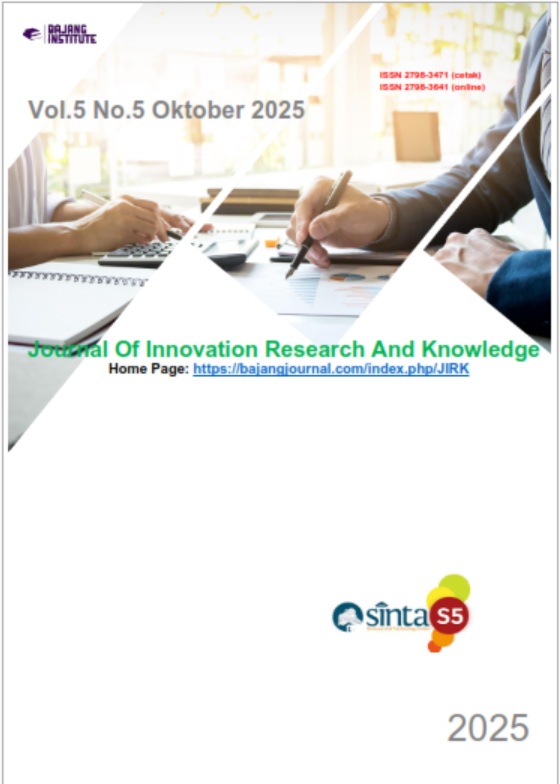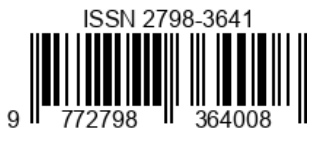AKTIVITAS ANTIBAKTERI ANTOSIANIN DAUN UNGU (GRAPTOPHYLLUM PICTUM L. GRIFF) TERHADAP STAPHYLOCOCCUS AUREUS DAN PENGEMBANGANNYA DALAM SEDIAAN GEL ANTI JERAWAT
Keywords:
Acne Gel, Antibakteri, Antosianin, Graptophyllum Pictum, Staphylococcus AureusAbstract
Penelitian ini bertujuan untuk mengisolasi dan mengevaluasi aktivitas antibakteri antosianin dari daun ungu (Graptophyllum pictum L. Griff) terhadap Staphylococcus aureus serta melakukan formulasi ke dalam sediaan gel antijerawat. Isolasi antosianin dilakukan secara maserasi menggunakan pelarut metanol-HCl dan diidentifikasi menggunakan Kromatografi Lapis Tipis (KLT) dengan hasil nilai Rf sebesar 0,38. Aktivitas antibakteri diukur menggunakan metode difusi cakram terhadap S. aureus, menunjukkan zona hambat signifikan yang meningkat secara dosis-respons, di mana konsentrasi 100% menghasilkan diameter hambat 17,27 mm (kuat). Sediaan gel antijerawat antosianin memiliki karakteristik fisik yang baik dengan pH 5,6, viskositas 190455,5 cP, dan daya sebar 48,62 mm. Hasil ini menunjukkan antosianin daun ungu layak dikembangkan sebagai bahan aktif antibakteri dalam sediaan topikal, dengan efektivitas dan karakter fisik yang relevan jika dibandingkan referensi sejenis. Pemanfaatan bahan alami ini juga merupakan solusi alternatif menghadapi masalah resistensi antibiotik pada terapi jerawat.
References
Atkinson, M., & Green, A. (2021). "Development of natural antimicrobial agents for acne treatment." Journal of Dermatological Research, 44(5), 377–384.
Kanedi, M., Handayani, K., Setiawan, W. A., Widodo, S., and Fitri, A. 2021. “Antibacterial activity of leaf extract of caricature plant (Graptophyllum pictum L.) against Staphylococcus aureus and Pseudomonas aeruginosa.” International Journal of Pharmaceutical Science and Researc. 6, no. 2: 1–3.
Jeyaraj, E. J., Vidana Gamage, G. C., Cintrat, J. C., and Choo, W. S. 2023. “Acylated and non-acylated anthocyanins as antibacterial and antibiofilm agents.” Discover Food 3, no. 1. Springer Nature. https://doi.org/10.1007/s44187-023-00062-8.
Tiwari, A. K., et al. (2013). "Antioxidant and antibacterial activities of anthocyanins from selected fruits." International Journal of Pharmacognosy, 5(8), 108–116.
Petruskevicius, A., Viskelis, J., Urbonaviciene, D., and Viskelis, P. 2023. “Anthocyanin accumulation in berry fruits and their antimicrobial and antiviral properties: An overview.” Horticulturae 9, no. 2. https://doi.org/10.3390/horticulturae9020288.
Dong, Y., Yang, C., Zhong, W., Shu, Y., Zhang, Y., and Yang, D. 2022. “Antibacterial effect and mechanism of anthocyanin from Lycium ruthenicum Murr.” Frontiers in Microbiology 13. https://doi.org/10.3389/fmicb.2022.974602.
Priyanto, J. A., Prastya, M. E., Minarti, M., and Permatasari, V. 2024. “Pharmaceutical properties and phytochemical profile of extract derived from purple leaf Graptophyllum pictum (L.) Griff.” Turkish Journal of Pharmaceutical Sciences 21, no. 2: 133–140. https://doi.org/10.4274/tjps.galenos.2023.95690.
Desai, R. A., Vijapur, L. S., Teradale, S. R., and Madhushree, M. 2022. “Formulation and evaluation of gel containing anthocyanin of Punica granatum L. extract for anti-inflammatory and anti-microbial activity.” Rajiv Gandhi University of Health Sciences Journal of Pharmaceutical Sciences 12, no. 3. https://doi.org/10.26463/rjps.12_3_2.
Deshpande, Twarita, Shivam Pal, Sadaf Shaikh, Sanjana Nilajkar, and Prince Yadav. 2024. “Formulation and evaluation of herbal anti-acne gel containing extracts of Tabernaemontana divaricata and Psidium guajava.” International Journal of Ayurveda and Pharma Research 12, no. 11: 23–28. https://doi.org/10.47070/ijapr.v12i11.3437.
Favaro, L. I. L., Balcão, V. M., Rocha, L. K. H., Silva, E. C., Oliveira, J. M., Vila, M. M. D. C., and Tubino, M. 2018. “Physicochemical characterization of a crude anthocyanin extract from the fruits of jussara (Euterpe edulis Martius): Potential for food and pharmaceutical applications.” Journal of the Brazilian Chemical Society 29, no. 10: 2072–2088. https://doi.org/10.21577/0103-5053.20180082.
Fei, P., Sun, Q., Guo, L., Jiang, L., Duo, K., Bi, X., and Yun, X. 2021. “Action mode of cranberry anthocyanin on physiological and morphological properties of Staphylococcus aureus and its application in cooked meat.” Food Microbiology. https://doi.org/10.1016/j.fm.2020.103632.
Alburyhi, M. M., Noman, M. A., and Saif, A. A. 2024. “Formulation and evaluation of natural herbal anti-acne as gel delivery systems.” World Journal of Pharmaceutical Research 13, no. 21: 1447–1467. https://doi.org/10.20959/wjpr202421-34558.
Fitriyani, R., Lestario, L. N., and Martono, Y. 2018. “Jenis dan kandungan antosianin buah Tomi–Tomi.” Jurnal Teknologi dan Industri Pangan 29, no. 2. https://doi.org/10.6066/jtip.2018.29.2.137.
Friska, Y. D., Hujjatusnaini, N., Ayatussa’adah, and Amin, A. Muh. 2021. “The potential of purple leaves ethanol extract (Graptophyllum pictum L.) against the growth of Staphylococcus aureus and Candida albicans.” Jurnal Agronomi Tanaman Tropika 3, no. 2: 196–197. https://doi.org/10.36378/juatika.v3i2.1325.
Hainil, S., Sammulia, S. F., and Adella. 2022. “Aktivitas antibakteri Staphylococcus aureus dan Salmonella thypi ekstrak metanol anggur laut (Caulerpa racemosa).” Jurnal Surya Medika (JSM) 7, no. 2: 86–95. https://doi.org/10.33084/jsm.v7i2.1234.
Lakshmikanthan, M., Muthu, S., Krishnan, K., Altemimi, A. B., Haider, N. N., Govindan, L., Selvakumari, J., Alkanan, Z. T., Cacciola, F., and Francis, Y. M. 2024. “A comprehensive review on anthocyanin-rich foods: Insights into extraction, medicinal potential, and sustainable applications.” Journal of Agriculture and Food Research 17. https://doi.org/10.1016/j.jafr.2024.101245.
Ramdan, S. R. K., and Fitriah, V. 2023. “Optimasi fase gerak pada isolasi dan identifikasi antosianin ubi jalar ungu (Ipomea batatas L).” Pharmacy Genius 2, no. 2: 135.
Richart, J. E., Salempa, P., and Faika, S. 2023. “Analisis kadar antosianin pada daun miana (Lamiaceae).” Jurnal Chemica 24, no. 1: 40–52.
Zhang, Z., Cao, M., Shang, Z., Xu, J., Chen, X., Zhu, Z., Wang, W., Wei, X., Zhou, X., Bai, Y., and Zhang, J. 2025. “Research progress on the antibacterial activity of natural flavonoids.” Antibiotics 14, no. 4. https://doi.org/10.3390/antibiotics14040334.













